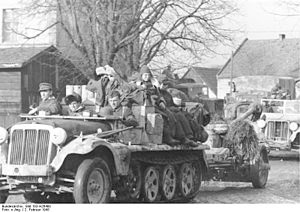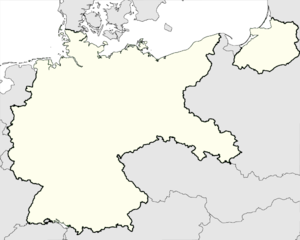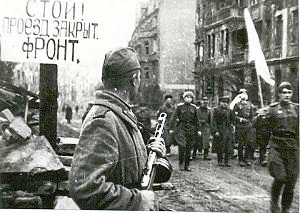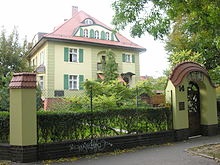Wroclaw, Poland




Siege of Breslau
From Wikipedia, the free encyclopedia
Siege of Breslau
Part of the Eastern Front of World War II
German troops in Breslau on February 2, 1945.
Date
February 13, 1945 - May 6, 1945 (2 months, and 24 days)
Location
Breslau, Germany
Result
Soviet victory
-
•Unconditional surrender of the city Breslau garrison on 6 May, followed by the unconditional surrender of all German forces two days after (see End of World War II in Europe)
Belligerents
Commanders and leaders
Festung Breslau:
Strength
87,334 soldiers
approximately 50,000 soldiers[1]
Casualties and losses
approximately 6,000 soldiers
approximately 30,000
soldiers and civilians
[show]
Soviet 6th Army[2] (1 March 1945)
[show]
Fortress Breslau[3] (February 1945)
The Battle of Breslau, also known as the Siege of Breslau, was a three month long siege of the city of Breslau in Lower Silesia, Germany (now Wrocław, Poland), lasting to the end of World War II in Europe. From February 13, 1945 to May 6, 1945, German troops in Breslau were besieged by the Soviet forces which encircled the city as part of the Lower Silesian Offensive Operation. The German garrison's surrender on May 6 was followed by the surrender of all German forces two days after the battle.
Preparations
In August 1944, Adolf Hitler declared the city of Breslau to be a fortress (Festung), ordering that it must be defended at all costs. He named Karl Hanke (Gauleiter of Silesia since 1941) to be the city's "Battle Commander" (Kampfkommandant).
On January 19, 1945, the civilian population was forced to leave (many thousands died in the bitter cold of the makeshift evacuation;[citation needed] many more arrived in Dresden,[citation needed] to be bombed a few weeks later). The German Army (Wehrmacht Heer), aided by the Home Guard (Volkssturm) and slave labourers, then turned the city into a military fortress: Breslau was to be capable of a lengthy defense against the advancing Soviets. A large area of the city center was demolished and turned into an airfield. Late in January, a regiment of Hitler Youth (Hitler-Jugend) was sent to reinforce the garrison of Festung Breslau. SS regiment "Besslein" (which included volunteers from France and the Netherlands) also took part.
On February 2, 1945, Hanke presented colors to the newly formed Home Guard units in Breslau. On the same day, Major General Hans von Ahlfen became the garrison commander of Fortress Breslau. Ahlfen, who commanded for only three weeks, had been personally selected by the Commander-in-Chief of Army Group Center (Heeresgruppe Mitte), Ferdinand Schörner.
On March 2, 1945, Infantry General Hermann Niehoff replaced Ahlfen as garrison commander. Niehoff held the position until the final surrender on May 6, 1945.
The siege
Breslau

Location of the Siege of Breslau
The city was besieged as part of the Lower Silesian Offensive Operation on February 13, 1945, by the 6th Army of the 1st Ukrainian Front commanded by Marshal Ivan Koniev, and the encirclement of Breslau was completed the following day. The 1st Ukrainian Front forces besieged the city with the 22nd and 74th Rifle Corps, and the 77th Fortified Region, as well as other smaller units. Even approximate estimates vary greatly concerning the number of German troops trapped in Breslau. Some sources claim that there were as many as 150,000 defenders, some 80,000 and some 50,000. The Siege of Breslau consisted of destructive house-to-house street fighting. The city was bombarded to ruin by artillery of the Soviet 6th Army, as well as the Soviet 2nd Air Army and the Soviet 18th Air Army. During the siege, both sides resorted to setting entire districts of the city on fire.
On February 15, the German Luftwaffe started an airlift to aid the besieged garrison. For 76 days, until May 1, the Luftwaffe made more than 2000 sorties with supplies and food. More than 1,638 short tons (1,486 t) of supplies were delivered. On February 22, the 6th Army occupied three suburbs of Breslau, and during the next day, the 6th Army troops were in the southern precincts of the city itself. By March 31, there was heavy artillery fire into the north, south, and west of Breslau suburbs. The 6th Army witnesses noted that much of the city was in flames. On April 20, General Niehoff had chocolates distributed to the troops in honor of Hitler's 56th birthday. On May 4, the clergy of Breslau — Pastor Hornig, Dr. Konrad, Bishop Ferche, and Canon Kramer — demanded that Niehoff surrender the town. Niehoff dismissed the clergy without a definitive answer. In the afternoon of the same day, Pastor Hornig repeated his demand in an address to the troop commanders. Hanke ordered Niehoff not to have any further dealings with the clergy.
Surrender
Delegation of German officers walking for negotiations before capitulation of Festung Breslau, 6 May 1945.
On 6 May, after 82 days of siege and shortly before the unconditional surrender of Germany in World War II, General Niehoff relinquished Festung Breslau to the Soviets. During the siege, Soviet forces inflicted approximately 30,000 civilian and military casualties and took more than 40,000 prisoners, while suffering 6,000 total casualties.[4] Breslau was the last major city in Germany to surrender, only two days before the end of the war in Europe. Gauleiter Hanke had fled to Prague by the time of the city's surrender.
Aftermath[edit]
Villa Colonia at Rapacki Street 14 (former Kaiser-Friedrich-Strasse), where the instrument of surrender of the Breslau garrison was written.
.
Not only because of Soviet aerial and artillery bombardment, but also as a result of the self-destructive actions of the SS and the NSDAP, 80 to 90 per cent of Breslau was destroyed . . . . after the Soviet capture of the Gandauer airfield, the Wehrmacht destroyed many houses and three churches to build a provisional airstrip 200 to 400 meters wide and two kilometers long.
— August 1945 report of damage to Breslau by employees of the Saxony state administration[5]
Breslau was transferred to Poland in the aftermath of the war and renamed Wrocław. Most of the German inhabitants in Wrocław fled or were forcibly expelled between 1945 and 1949 and moved to Allied Occupation Zones in Germany. A small German minority still remains in the city.
















